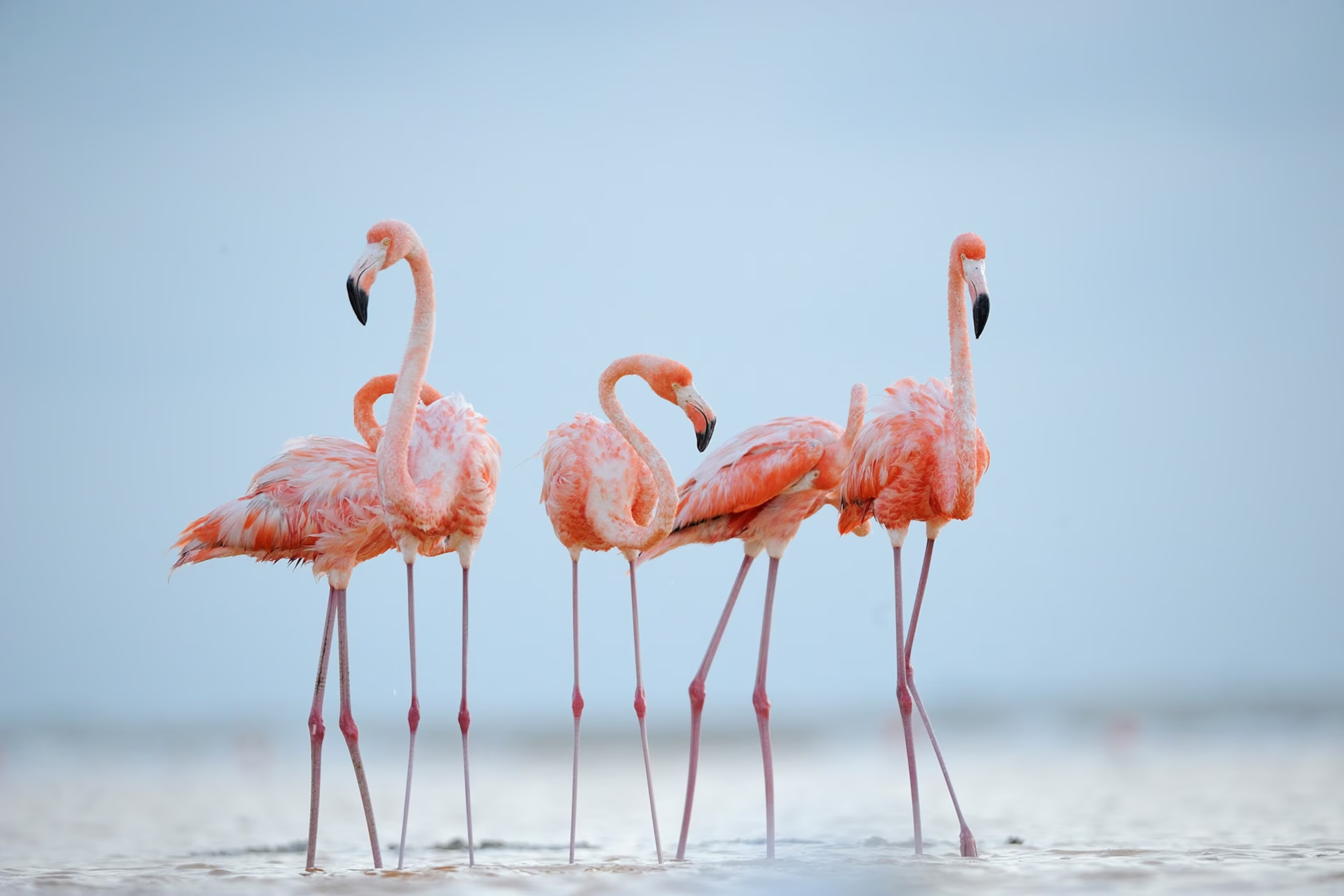5 Fascinating Facts About Flamingos (Phoenicopteridae)
The Blazing Beacons of Africa’s Wetlands
Few sights in the natural world are as mesmerizing as a flock of flamingos—their vivid pink plumage set against shimmering lake waters, their long legs wading through shallows with an effortless grace. But beyond their flamboyant appearance lies a world of biological wonder, behavioral complexity, and ecological importance.
Flamingos, scientifically classified under the family Phoenicopteridae, are more than mere icons of elegance; they are survivors, engineers, and communicators in their ecosystems. Found across Africa’s saline and alkaline lakes, these birds embody adaptation at its finest.
Here are five incredible facts about flamingos that showcase why these birds are not only captivating but essential to understanding the delicate balance of Africa’s wild habitats.
1. Their Pink Color Comes From Their Diet (Facts About Flamingos)
One of the most distinctive traits of flamingos is their brilliant pink coloration—but they aren’t born that way. Flamingo chicks hatch with grayish-white feathers, and their signature pink hue only develops as they grow older, thanks to their diet.
Carotenoids: The Secret Pigment
Flamingos feed primarily on blue-green algae, crustaceans, and plankton, which are rich in carotenoid pigments. As their bodies digest these foods, the pigments are broken down into colored molecules, which are then absorbed and deposited in the feathers, skin, and even the beak.
This vibrant pink not only serves as a visual identifier but also as a health indicator. The brighter the flamingo, the healthier and more desirable it appears to potential mates.
2. Flamingos Are Masters of Alkaline Lake Habitats
While many animals shy away from extreme conditions, flamingos thrive in some of Africa’s most inhospitable environments. They congregate in vast numbers in alkaline or saline lakes, such as Lake Natron in Tanzania and Lake Bogoria in Kenya, where few other species can survive.
Highly Specialized Beaks and Feeding Techniques
Flamingos have uniquely adapted beaks that allow them to filter microscopic food from the water. Using an upside-down feeding motion, they suck in water and pump it through comb-like structures called lamellae to trap algae and tiny invertebrates.
Their long legs and webbed feet help them wade into deeper, saltier water where food is abundant. In these settings, flamingos play a critical role in maintaining ecosystem balance, often serving as bioindicators for lake health.
3. They Are Incredibly Social and Synchronized
Flamingos are not solitary creatures. In fact, they are among the most social birds on the planet, forming colonies that can number in the hundreds of thousands. This social structure is not just for safety in numbers—it’s essential to their survival and reproductive success.
Courtship Rituals and Synchronization (Facts About Flamingos)
During mating season, flamingos engage in elaborate group displays where dozens, even hundreds, of birds perform synchronized movements—head-flagging, wing-saluting, and marching in unison. These rituals are critical for pair bonding and reproductive timing.
Once mated, a bonded pair builds a volcano-shaped mud nest in shallow water and lays a single egg. Both parents share responsibilities, from incubating the egg to feeding the chick with crop milk—a protein- and fat-rich secretion similar to mammalian milk.
Chick Crèches
After hatching, chicks gather in large groups called crèches, where they are supervised by a few adults while their parents forage. This behavior improves survival rates and reflects the communal spirit that defines flamingo societies.
4. Flamingos Communicate in Remarkably Complex Ways
Flamingos may not be known for their vocalizations like songbirds, but their communication methods are both diverse and effective.
Vocal and Visual Signals
Flamingos use a variety of grunts, honks, and low-frequency sounds to communicate, especially in dense flocks. These sounds are essential for maintaining group cohesion, alerting others to danger, and coordinating breeding behaviors.
Visual signals, such as posture, head movements, and plumage displays, also convey information about an individual’s mood, mating readiness, or hierarchical status.
In their crèches, flamingo chicks recognize and respond to individual calls from their parents, a vital skill in an environment where tens of thousands of birds look and sound similar.
Long-Distance Navigation
Flamingos are capable of long migratory journeys and are believed to use celestial cues, magnetic fields, and even olfactory signals to navigate. Their ability to return to the same breeding and feeding grounds year after year is a testament to their cognitive abilities and memory.
5. They Are Ecosystem Engineers and Conservation Indicators
Beyond their charm and beauty, flamingos serve as keystone species in their habitats. Their feeding activities stir up nutrients, promote algal growth, and help maintain the overall health of wetland ecosystems.
Environmental Sentinels
Because flamingos are sensitive to changes in water quality, salinity, and food availability, their presence—or absence—often serves as an early warning sign of ecological degradation. Conservationists monitor flamingo populations to assess the health of lake environments across Africa.
Conservation Challenges
Despite their resilience, flamingos face numerous threats, including habitat loss, climate change, and human disturbance. For example, plans to build industrial projects near Lake Natron could disrupt breeding colonies and cause population declines.
Ongoing conservation efforts focus on protecting flamingo habitats, enforcing anti-disturbance laws, and engaging local communities in sustainable tourism practices that benefit both wildlife and people.
The Flamingo: A Marvel of Adaptation and Elegance
The flamingo is far more than a pretty face in the wetlands. It is a symbol of adaptation, intelligence, and resilience—a bird that thrives in the harshest of habitats while nurturing some of the most complex social systems found in the avian world.
From its dietary pigments that paint it pink, to its finely tuned communication systems and vital ecological roles, the flamingo commands admiration and respect. By understanding and protecting these magnificent birds, we ensure the survival of the delicate ecosystems they help sustain.
See Flamingos in Their Element with WildHorn Africa
To experience the majesty of Africa’s flamingos in their natural habitat, nothing compares to a professionally guided safari. WildHorn Africa offers immersive wildlife expeditions to Lake Nakuru, Lake Natron, and other flamingo-rich sanctuaries, where you can witness flocks of thousands dancing across reflective waters.
With personalized itineraries, experienced guides, and a deep commitment to conservation, WildHorn Africa brings you closer to the continent’s most enchanting wildlife experiences.
Book your African tour today with WildHorn Africa – and step into the world of the extraordinary flamingo.
Facts About Flamingos #Facts About Flamingos Facts About Flamingos





 WildHorn Africa – Authentic and unforgettable tours across Africa, guided by local experts who know the land, wildlife, and culture best.
WildHorn Africa – Authentic and unforgettable tours across Africa, guided by local experts who know the land, wildlife, and culture best.


